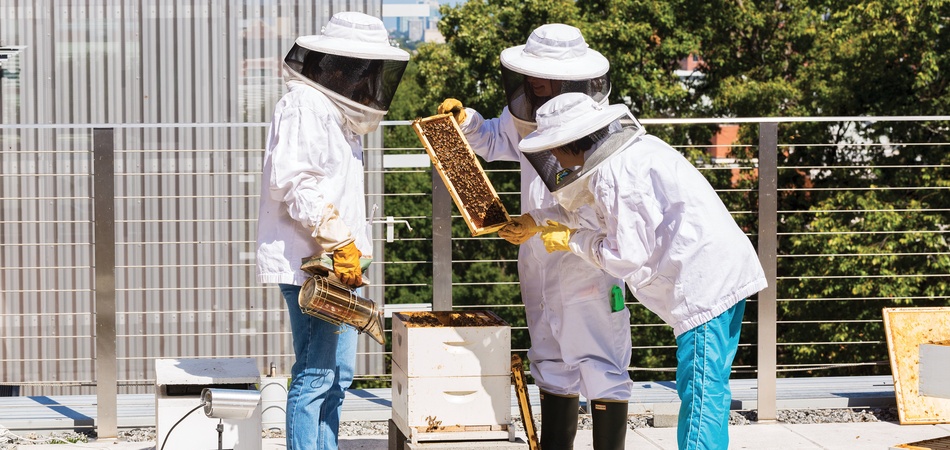Honoring the land on which we build and its connection to community, ecology, and sustenance
“The intent of the Place Petal is to realign how people understand and relate to the natural environment that sustains us.” International Living Future Institute
The natural and cultural history of the land on which The Kendeda Building is built is rich and storied. While the Beauty Petal and its Inspiration + Education Imperative asks teams to look at the site and its surrounding region’s cultural heritage, the Place Petal focuses first and foremost on the environmental heritage. The Piedmont region, of which our site is a part, naturally features a variety of plants and soils – not an expanse of concrete.
While we cannot account for the full impact of development as our town and cities grow, the Place Petal, like the rest of the Living Building Challenge (LBC), asks us to do the least harm possible. It asks us to think about ways to bring back biodiversity and restore our water and land resources slowly, to stray from the car-centric development that is commonplace and instead consider pedestrians first, and to think about the natural lands beyond our backyard and how to partner in preservation. To meet these objectives, The Place petal asks us to respect the natural state of the land on which we build and consider that land’s connection to other resources. The Place Petal in LBC v. 3.1 has four requirements, called Imperatives: Limits to Growth, Urban Agriculture, Habitat Exchange, and Human-Powered Living.
Limits to Growth: Not Taking More than We Need
The Living Building Challenge recognizes that the impact of building on land that has not been previously developed is much greater than building on land that has. The Limits to Growth Imperative requires that projects be built only on greyfields or brownfields (previously developed sites that are not classified as or adjacent to ecologically-sensitive habitats). In addition, projects may not be built in ecologically-sensitive habitats, including wetlands, primary dunes, old-growth forest, virgin prairie, prime farmland, or within the 100-year floodplain. To the extent possible, project teams should try to emulate the site’s natural landscape, and no petrochemical fertilizers or petrochemical pesticides can be used for maintaining the landscape.
The Kendeda Building is built on the site of a former parking lot on the northwest corner of Ferst Drive and State Street on Georgia Tech’s campus. Restoring this land to pre-development conditions was a difficult task, as dirt on site had been compacted for decades. Soil testing, however, found that only minimal soil amendments were necessary to restore the soil to a healthy state. Andropogon Associates, the project’s landscape design team, researched the natural water flows of the site in order to mimic those flows and developed a planting palette that included a variety of plants native to the region – selected both for hardiness, beauty, and diversity. Among a variety of plants, the site hosts Cherokee Sedge, Echinacea, Golden Rod, and several plants with edible fruits or flowers.
Urban Agriculture: On-Site Sustenance
A self-sustaining site must be able to produce food, and the LBC recognizes this through its Urban Agriculture Imperative. The building’s density (gross square meters of development/total area of the project site), also known as its floor-to-area ratio (FAR), dictates what percentage of the site must be dedicated to producing food for human consumption. The FAR of The Kendeda Building requires that the project dedicate 20 percent of the site, or approximately 12,600 square feet, to urban agriculture.
Like all the pieces of the LBC, the strategy for urban agriculture is dependent upon and influences other facets of design. The large number of trees planted to provide shade for the building and thus reduce the energy needed for cooling affect how much sunlight is available on site. Both the site area needed for greywater treatment and the site area needed to create accessible, connective pathways affect the size and shapes of spaces available for growing.
Because of the shade produced by trees, the limited site area, and the steep slope of the site, row crops were not an ideal solution. Instead, the team chose a mixed approach – part foraging landscape, with plants throughout the landscape that can be harvested for food, part rooftop garden with blueberry bushes, and part fruiting vines that live on the building sides.
CHANGES FROM LBC 3.1 TO 4.0
ILFI has made several changes to this Imperative. While on-site or scale-jumped urban agriculture is still required, the percentage is now based on Transect not floor area ratio. Furthermore, project teams can provide weekly access to locally grown fresh food in combination with a reduced amount of urban agriculture. A significant change is that on-site food storage is now required for all non-residential projects, and on-site food storage capacity is required for all residential projects.
Habitat Exchange: Conserving Natural Spaces
Recognizing that no development is free of impact, the third Imperative under Living Building Challenge v. 3.1 Place Petal, Habitat Exchange, requires that “for each hectare of development, an equal amount of land away from the project site must be set aside in perpetuity through the [International Living Futures] Institute’s Habitat Exchange Program or an approved land trust organization.” The minimum preservation area is 0.4 hectares, which is equal to approximately one acre. Otherwise, the area preserved must be equal to the project area.
The Kendeda Building site is approximately 1.35 acres (0.55 hectares). The International Living Future Institute requires that the project identifies a natural area and enters into a contract for its preservation prior to certification. The Imperative, however, does not require that the land be within a certain distance of the site, or even in the same state, so multiple options may be explored. After exploring options, the project decided to support the International Living Futures Institute's Habitat Exchange Program.
Human-Powered Living: Reducing the Impact of our Movements
People get to The Kendeda Building site in a variety of ways: on foot, by bike, on public transit, and in cars. The goal of the final Imperative of the Place Petal, Human-Powered Living, is to provide resources and connectivity for those arriving on site by walking, biking, or taking public transit. LBC v. 3.1 requires that each Living Building produce a mobility plan that shows:
- Covered storage for human-powered vehicles (bikes, skateboards, etc.);
- Consideration and enhancement of pedestrian routes;
- Promotion of the use of stairs over elevators inside the building; and
- Community advocacy to facilitate the uptake of human-powered transportation.
Georgia Tech also has multiple bus routes that serve campus and its surrounding areas and connect Georgia Tech to MARTA and Emory University. These buses and shuttles run at a high frequency and are available to everyone, not just those associated with Georgia Tech. The Tech Trolley, a popular route that connects the campus with the Midtown MARTA transit station, has a stop at The Kendeda Building.
In addition to bicycle, pedestrian, and transit infrastructure, the building also has two showers, important resources for commuters in the humid Southeast.
CHANGES FROM LBC 3.1 TO 4.0
This Imperative is now called Human-Scaled Living to encourage the creation of communities that are compact, connected, and pedestrian scaled. ILFI combined and modified requirements from LBC 3.1 Imperative 04, Human-Powered Living and LBC 3.1 Imperative 15, Human Scale + Humane Places. Key changes include:
- New requirements to implement best practices or document a reduction in trips by single occupancy vehicles and fossil fuel-based vehicles;
- Adjusted requirements for parking, bike storage, and electric vehicle charging stations; and
- A new requirement for project teams working on single-family residential projects to create a single occupancy vehicles trip reduction plan and implement at least two of the strategies identified in the plan.

Rooftop Pollinators

Teams can also count land used to raise livestock, poultry, or other eco-system supporting animals towards the urban agriculture requirement. Georgia Tech’s Urban Honey Bee Project led by Dr. Jennifer Leavey through the College of Sciences, seemed a natural fit for the rooftop garden. The flowering plants that support the on-site bees can also be counted towards the required square footage for urban agriculture. Georgia Tech is one of 76 certified Bee Campuses in the nation.